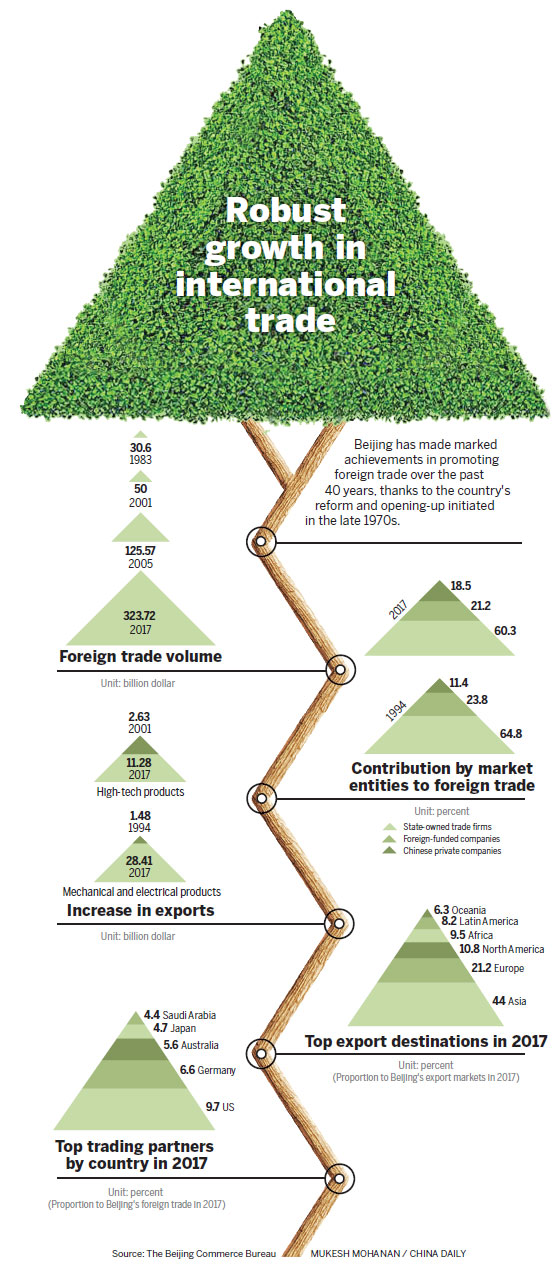City revs up to further open economy
Strong growth, optimized structure propel international trade volume to $323.72 billion
Beijing is revving up efforts to further open its economy, featuring strong growth and optimized structure in foreign trade.
The city has made marked progress in international trade over the past 40 years, thanks to the country's reform and opening-up initiated in the late 1970s.

The city's foreign trade volume increased from $30.6 billion in 1983 to $323.72 billion in 2017, reporting an average annual growth of 8.8 percent and accounting for 7.9 percent of the country's total.
The trade volume surpassed the benchmark of $50 billion in 2001, reaching $51.54 billion. It topped $100 billion in 2005, rising to $125.57 billion. The amount surpassed $200 billion in 2008 and $300 billion in 2010. By 2012, the figure exceeded $400 billion.
In export, Beijing surpassed $20 billion in 2004. In the following three years, Beijing's export volume surpassed the benchmarks of $30 billion, $40 billion and $50 billion, respectively. Exports reached the pinnacle of $63.2 billion in 2014 and fell to $58.5 billion in 2017.
In import, the city surpassed $50 billion in 2003, and exceeded the benchmarks of $100 billion in 2006 and $200 billion in 2008. The volume reached a pinnacle in 2013, worth $365.86 billion, and fell to $265.22 billion in 2017.
Optimized structure
During the early stage of the country's reform and opening-up, the city's foreign trade market was dominated by State-owned enterprises.
In 1992, private businesses began to play an active part in the city's exports and imports, though more than 80 percent of the city's foreign trade was still conducted by State-owned trade firms.
In 1994, SOE's proportion to foreign trade dropped to 64.8 percent, with Chinese-funded exporters contributing 11.4 percent and foreign-invested ones accounting for 23.8 percent.
In 2017, export by SOEs accounted for 60.3 percent of the city's total, a dip of 7.5 percent from a year earlier. Foreign-funded companies contributed 21.2 percent and the proportion of private businesses was 18.5 percent.
The city's overseas shipments of mechanical and electrical products stood at $1.48 billion in 1993, accounting for 22 percent of the city's total exports.
The amount surged to $28.41 billion last year, 19.2 times that of 1993.
High-tech products also gained a strong growth momentum in exports, from $2.63 billion in 2001 to $11.28 billion in 2007.
With the rapid growth in foreign trade, Beijing has expanded its links with more traders.
Before the country's reform and opening-up, some 80 countries and regions traded with Beijing. The number increased to 189 in 1996 and surpassed 230 in 2017.
Last year, 44 percent of the city's foreign trade was conducted in Asia, 21.2 percent involved Europe and 10.8 percent was connected with North America.
The United States was the city's largest trading partner in 2017, followed by Germany and Australia.
Japan and Saudi Arabia took fourth and fifth position, respectively.
Trade in services
In 2017, emerging services accounted for 62.7 percent of the city's total exports, increasing 11.6 percentage points from 2003.
Beijing's development in the cultural and technological sectors, as well as outsourced services, is at the forefront of the country.
Between 2006 and 2017, the city's foreign trade in cultural products and services was $43.69 billion, with an average annual growth of 12.2 percent, including $18.02 billion in exports and $25.68 billion in imports.
A total of 69 companies and 36 projects from Beijing were on the 2017-18 list of the key national cultural export businesses and projects.
The China Beijing International Fair for Trade in Services, an annual event aimed at promoting the healthy growth of the sector, showcases the host city's emphasis on the sector.
The latest session from May 28 to June 1 attracted nearly 100,000 businesspeople from 122 countries and regions, as well as representatives of seven international organizations and some 100 trade associations.
At this year's event, 311 deals were signed worth $102.56 billion in combined contract value.
Of the deals, 110 involved foreign parties, totaling $17.25 billion and accounting for 16.8 percent of the total value.

(China Daily 12/28/2018 page7)














